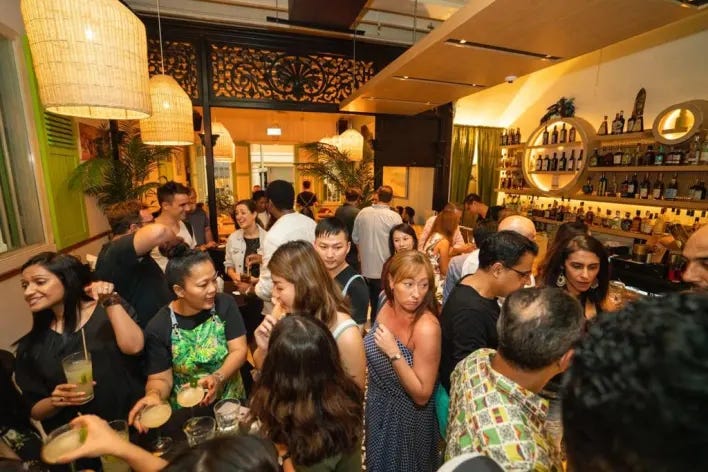Burnt Ends: What really put the lights out at Lime House's party
How management of the beloved Caribbean-themed restaurant gradually lost their way.
📌 Burnt Ends is a series that dives into F&B business failures and examines the causes behind them.
This week's story covers a controversial business failure. At the request of all sources that Commune has spoken to, we have omitted mention of any names and provided only a high-level overview of events. When Lime House opened its doors in 2013, most Singaporeans had never heard of Jamaican Jerk Chicken or Trinidadian Doubles. Nestled in Jiak Chuan Street — then an emerging food enclave — the restaurant had to compete for attention in a neighbourhood fast filling with buzzier names.

Those challenges didn’t keep the crew from dreaming big. From 2013 to 2025, Lime House’s menu expanded from a modest 25 to 30 rotating dishes to more than 100, and it also housed one of Singapore’s most expansive rum collections. A regular roster of events, including standup comedy shows, closed-door fashion showcases, live DJ sets, and exclusive bartending sessions, drew in crowds that poured out into the street.
But the good vibes didn’t last. In August 2023, a post on Lime House’s Instagram handle announced the closure of its second outlet at East Coast, citing rising costs as the key reason for the decision. A few months later in February 2024, the flagship outlet at Jiak Chuan Street would also shutter for good.
The truth wasn’t so simple. Beneath the frequent laments of runaway rental costs and manpower shortages is an untold story of management conflict, and how it led to a series of bad decisions that dragged Lime House further away from the features that truly made it shine.
What Lime House got right
Lime House nailed its value proposition from the start: high quality Caribbean fare at affordable prices, in a community that prides itself on genuine hospitality.
Lime House recognized that hospitality and service are two different things, something that most F&B businesses overlook. There was no upselling or hurrying of the guests. Whether the bill was five or five hundred dollars, patrons received the same level of warmth. Some, according to a source that Commune spoke with, got to know the staff so well that they invited them to foreign weddings.
A key component of the brand's initial go-to-market strategy was events. Lime House evolved from a restaurant to a cultural hub, hosting everything from rum masterclasses with Maison du Whisky and Black Tot Rum to DJ-driven block parties, fashion pop-ups with Binary Style, and live events like the Afroheat series and Bumbastic Fridays. One event, claimed by a source who was privy to Lime House’s events lineup, attracted 2,000 people at its height.

This was deliberate. The group was aware that Singaporeans were constantly searching for something new. Small bites were frequently served at events, providing a convenient means of introducing Caribbean cuisine to people with different palates.
Lime House’s adaptability became its greatest asset during the COVID-19 lockdowns. Within 48 hours, the team launched an e-commerce site complete with menus and visuals. Staff took on logistics roles, and for a single corporate event, they delivered 30 meals across the island — each one accompanied by a handwritten note. Between 2019 and 2021, these efforts helped the restaurant double its revenue despite mounting industry-wide cost pressures.
Beyond food, the brand's attention to detail was evident. Bar managers and senior restaurant executives frequently took guests on rum flights, explaining the history of Caribbean rum and its tasting notes.
Where Lime House faltered
As a restaurant that operated in Singapore’s highly competitive food and beverage landscape, Lime House was no stranger to exorbitant rent or the lack of quality manpower hires.
But insiders suggest the real trouble started within. According to multiple sources familiar with the situation, disagreements in operational vision created a leadership divide. What followed were a series of missteps that gradually pulled Lime House away from the very values it was built on.
For one, the relaxed dining experience that customers loved Lime House for was replaced by timed slots. Diners, once entitled to stay for as long as they wished to, were suddenly told to leave once their reserved slot was up. The abrupt shift in concept, according to sources, severely disrupted back-of-house operations.
As ingredient costs surged, management quietly cut portion sizes without adjusting prices or informing regulars. Rather than relying on data or customer feedback, menu decisions became increasingly arbitrary, eroding the trust Lime House had spent years building.
The second outlet expansion also drove another nail into Lime House’s coffin. Despite the flagship branch’s popularity, Lime House still did not have a stable customer base that could smoothen out any drastic changes to its bottom line. The second outlet also increased staffing and rent costs, straining the business further. Sources that Commune spoke to declined to comment on exact figures.
In the end, Lime House didn’t close because Singaporeans weren’t ready for Caribbean food or because rising costs made it impossible to operate. It closed because, somewhere along the way, it lost sight of what made it special. What had once felt like a gathering among friends slowly became a business trying to keep up, and in the process, something essential was lost.


